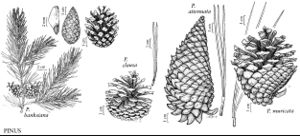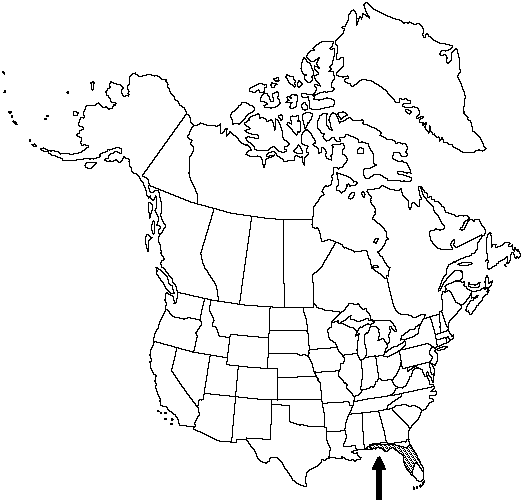Pinus clausa
Rep. For. N. America 199. 1884.
Trees to 21m; trunk to 0.5m diam., straight and erect to leaning and crooked, much branched; crown mostly rounded or irregular. Bark gray to gray-brown, furrowed, with narrow, flat, irregular ridges, resin pockets absent, on upper sections of the trunk reddish to red-brown, platy becoming smooth distally. Branches spreading to ascending, poorly self-pruning; twigs slender, violet- to red-brown, rarely glaucous, aging gray, smooth. Buds cylindric, purple-brown, to 1cm; scale margins white-fringed. Leaves 2 per fascicle, spreading-ascending, persisting 2–3 years, (3–)6–9(–10)cm × ca. 1mm, straight, slightly twisted, dark green, all surfaces with fine, inconspicuous stomatal lines, margins finely serrulate, apex short-conic; sheath 0.3–0.5(–0.7)cm, base persistent. Pollen cones ellipsoid, ca. 10mm, brownish yellow. Seed cones maturing in 2 years, shedding seeds soon thereafter or often long-serotinous, long-persistent, solitary or whorled, spreading, symmetric (rarely slightly asymmetric, reflexed), lanceoloid before opening, ovoid to broadly ovoid when open, 3–8cm, red-brown, sessile or on stalks to 1cm, scales with dark red-brown, purple, or purple-gray border distally on adaxial surface; apophyses thickened, shallowly and angulately raised, transversely rhombic, cross-keeled; umbo central, low-pyramidal, tapering to sharp tip or weak, often deciduous prickle. Seeds obovoid-oblique; body ca. 4mm, dark brown to nearly black; wing to 17mm. 2n =24.
Habitat: Fire successional in sand dunes and white sandhills
Elevation: 0–60m
Discussion
Although Pinus clausa is too profusely branched to be important for saw timber, it is managed to produce a high volume of pulpwood in northern peninsular Florida.
Selected References
None.

